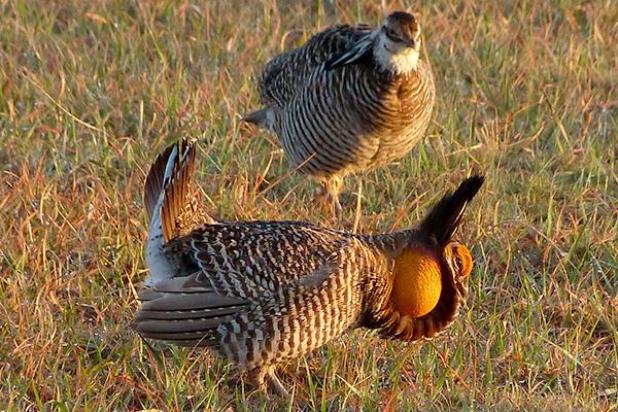
Greater prairie chickens, which put on a show during their spring breeding season, are now flourishing in northeast Colorado after dipping to dangerously low numbers decades ago. — Wayne D. Lewis
Northeast Colorado celebrates greater prairie chicken success story
Once a state endangered species that dipped to population levels as low as 600 birds in Colorado in 1973, greater prairie chickens are now flourishing in the grasslands of the northeast corner of the state.
This is a tremendous success story — the recovery of the species. It would not have happened without the cooperation of landowners with what was then Colorado Division of Wildlife staff.
Colorado is one of the bright spots for greater prairie chickens as the species is really struggling over a large portion of its historic range.
“Greater prairie chickens are doing well in Colorado, Nebraska, part of Kansas and parts of South Dakota,” said Trent Verquer, grassland habitat coordinator for Colorado Parks & Wildlife. “Elsewhere in their range they are not doing well, and Colorado has a real role for this species.”
CPW officials believe the core range in Colorado lies primarily in seven counties bordering Kansas and Nebraska. They are abundant in that range and sure do draw an audience. People from around the globe come to see the birds on their display grounds, called leks, in March and April during their breeding seasons.
Greater prairie chickens are most abundant in Yuma, Washington and Phillips counties with Logan, Sedgwick, Kit Carson and Morgan counties seeing some leks.
It is also during that spring season when wildlife officials are surveying the species to monitor their population numbers. In 1993, the birds were delisted from being a state endangered species, and the population has grown to the point that it can now sustain a limited harvest each year.
Wildlife officials have 10 specific survey routes they run — five one year and the other five the following — which have been monitored for two decades to get a density estimate of greater prairie chickens on the landscape.
They look for the leks, and their observations from the last 20 years is that the population is stable. CPW wildlife biologist Wendy Figueroa estimated there could be around 10,000 in Colorado, but that exact number is hard to pin down.
“Now when we have opportunities to survey for leks in areas off the established routes, we do find new leks which makes regular surveys and monitoring very important,” Figueroa said. “This adds to our knowledge of where greater prairie chickens are on the landscape and how they are dispersed on their range.”
Greater prairie chickens can be found on sand sagebrush rangeland, in medium-tall grass or on previously farmed cropland that has been reestablished to grassland habitat via the Conservation Reserve Program.
The full article is available in our e-Edition. Click here to subscribe.
